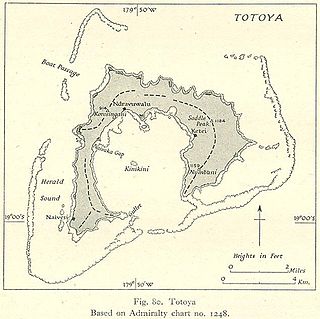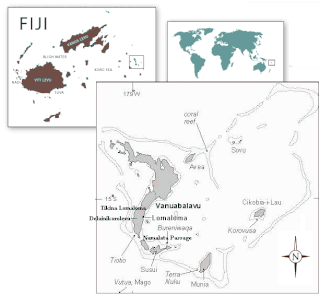Tui Nayau is the title held by the paramount chief of the Lau Islands in Fiji and is synonymous with the title holders over lordship of these islands. When translated, Tu’i Nayau means "Lord of Nayau", an island north of Lakeba.
Radini Nayau is the courtesy title given to the wife or chief wife of the Tu'i Nayau, Chief of the Lau Islands in Fiji. The bearer of title is installed at the same time as the Tui Nayau. In the past when polygamy was the norm and the Tui Nayau had many wives, the chief or senior wife bore this title.
Uluilakeba was the eldest son of Niumataiwalu. He did not succeed to his fathers title, first since his father was not known to have been installed to the title of either Tui Nayau or Sau ni Vanua ko Lau, second in the test of feat that had ensued to select the candidate for the title of Tui Nayau he was known to have been one of the two sons of Niumataiwalu who had backed down from the unnerving jump that was put to them by the Bete. In that test of feat it was said as related orally that he as an excuse to allay any possible accusation of cowardice on his part said that since he was the eldest his claim to the title was already established by birthright and thence there was no need for him to prove himself. Rasolo then on the account of his elder brothers excuse, the second eldest of the three then took up the challenge, after Matawalu the youngest had also surrendered up any idea of contesting.
Rasolo was a Fijian High Chief.
The Lau Islands of Fiji are situated in the southern Pacific Ocean, just east of the Koro Sea. Of this chain of about sixty islands and islets, about thirty are inhabited. The Lau Group covers a land area of 188 square miles, and had a population of 10,683 at the most recent census in 2007. While most of the northern Lau Group are high islands of volcanic origin, those of the south are mostly carbonate low islands.

Totoya is a volcanic island in the Moala subgroup of Fiji's Lau archipelago. It occupies an area of 28 km2, making it the smallest of the Yasayasa Moala Group. Its maximum elevation is 366 metres above sea level. The main economic activity is coconut farming.
Dranivia was an 18th-century Lauan chief and noble of the Vuanirewa dynasty. He was the third son of Uluilakeba I and last recorded member of the noble household, Naivi, to hold the title Roko Sau of the Lau Islands. He is referred to as an usurper and often oral history does not include hims as a Roko Sau. He is said to have snatched the chieftainship during the absence of his uncle Matawalu from Lakeba, and without the consent of the Vuanirewa. On hearing of his nephew's treachery, Matawalu returned from Bau and reasserted his authority, while Dranivia was touring the Southern Lau islands. Dranivia immediately returned to Lakeba which precipitated in kin slaying amongst the Vuanirewa. Dranivia was defeated and he fled with his supporters to Nayau and establishing the village of Liku.
Viliame (William) Vuetasau (c.1820-1857) was a Fijian explorer who was the son of Roko Malani, the seventh Roko Sau of Lau and second Tui Nayau and Ciri of Taqalevu. During the reign of his Uncle Taliai Tupou, third Tui Nayau, he was considered heir to the title. He was the first of his noble line to be given a western name, William, after Willam Cary, survivor of the Nantucket whaling ship Oeno that was wrecked in the Lau Islands in 1825. William Cary was rescued by a brother of Malani, who in time became close friends with Malani himself, who named his son after the New Englander, demonstrating his attachment to the shipwrecked sailor.
Matawalu was a Fijian chief. He was the son of Niumataiwalu—first Roko Sau of Lau Islands—and Uma of Nukunuku.
Ratu Alifereti Finau was the eleventh Sau ni Vanua of Lau and the fifth Tui Nayau. He was a member of the noble household Matailakeba.
RokoMalani was high chief of the Fijian island of Lakeba. He held the title Tui Nayau and was a popular chief. He increased the influence the island of Lakeba had in Fiji.
Toki Soroaqali was a Lauan chief and member of the noble dynasty of Vuanirewa in Fiji, active in the late 1700s and early 1800s.
Roko Taliai Tupou (17??-1875) was a Fijian nobleman. He is considered to be the progenitor of the noble household Vatuwaqa in the chiefly Vuanirewa clan and as such, was the first member of this noble household to hold the title Tui Nayau. His reign marked the growth of Christianity in Lau and the slow expansion of Tongan ambitions in Fiji, led by Enele Ma'afu. As this period marked increasing contact with Europeans, records from this point forward in regard to the history of Lau are well documented.
Sau Mai Kedekede now more commonly referred to as Sau ni Vanua ko Lau is one of the preeminent titles held by the Paramount Chief of the Lau Islands in Fiji.
Roko is a title of chiefly rank, specifically from the Lau Islands of Fiji.

Turaga na Rasau is a traditional Fijian chiefly title of the Lau Islands. Prior to Fiji's colonial days, Fiji had many different Vanua with their own Paramount Chieftain which exercised no authority over the other; a saying from the island of Kadavu aptly summarises it "Nomu Turaga o sega na noqu Turaga" or "Your Chief is not my Chief" also the people of Beqa Island were of a similar opinion saying "Qali Cuva Ki Lagi" or "Subject only to heaven" and would bow to no outside Chieftain, but at the turn of the 20th century aspects of the traditional social structure remained, but for administrative purposes three main Matanitu were solidified and formed as they were the dominant consolidated powers at the time being that of Kubuna, Burebasaga and Tovata. With regard to the Rasau while its traditional origins were in Kubuna on Bau the titles traditional authority in modern Fiji is now in Tovata, Lau in particular Lomaloma Tikina on the Island of Vanua Balavu.
Kalouyalewa was a Fijian High Chief.
Ratu Jione Atonio Rabici "Tom" Doviverata was a Bau chief and medical doctor and administrator in colonial Fiji.
AdiLalaciwa was a Fijian chiefess and member of the Vuanirewa dynasty on the Lau Islands of Fiji.
Malani may refer to: